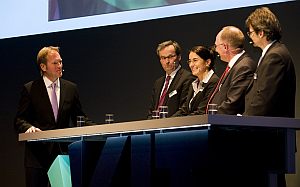At this year’s annual reception, Karlsruhe Institute of Technology (KIT) demonstrated how the two worlds of science and industry can be linked in an advantageous way. The reception focused on innovation, the third strategic pillar of KIT apart from research and teaching. Presidents Professor Eberhard Umbach and Professor Horst Hippler underlined the wide spectrum covered by KIT’s innovation potential and its international visibility. Interviews and films illustrated how specific cooperation may pave the way from the idea to the marketable product. Best example: The environmentally compatible cement Celitement.
The event at the Karlsruhe Hochschule für Gestaltung (University for Design) was the first annual reception of KIT as a legally merged institution. The merger gives rise to synergy effects that would not have been achieved by simple cooperation, as was explained by Eberhard Umbach. First successes have already been reached. The KIT president mentioned the “InnoEnergy” Knowledge and Innovation Community (KIC) that will be coordinated by KIT and is aimed at designing a sustainable energy system for Europe until 2050. This European consortium consists of 35 partners, among them, universities, research institutions, business schools, and enterprises.
KIT President Horst Hippler referred to KIT as the most successful German institution in the acquisition of European research funds. Under the 6th EU Research Framework Programme, KIT acquired funding of more than 80 million Euros and was involved in more than 200 research projects. Students and cooperation partners profit from KIT’s strength in research.
The Chairman of the KIT Founding Supervisory Board and President of the Helmholtz Association, Professor Jürgen Mlynek, underlined the importance of strong fundamental research as a foundation of innovation. He pointed out that KIT combines excellent research with strategic relevance and addresses the big issues of the future, such as energy and climate. The President of the Karlsruhe Chamber of Industry and Commerce, Bernd Bechtold, underlined the fact that KIT with its more than 8000 employees is the largest employer in the region. Every year, it invests about 60 million Euros in goods and services. KIT’s students represent an annual purchasing power of about EUR 350 million. According to Bechtold, KIT is an immense economic factor and a symbol reflecting the chances of the region.
To bring together science and industry, KIT focuses on three dimensions of innovation, as was pointed out by the Vice President for Research and Innovation, Dr. Peter Fritz, in an interview with moderator Markus Brock from the SWR broadcasting station. The dimension of “know-how transfer” covers personal contacts to industry partners in so-called shared research groups and shared professorships. The dimension of “business development” is aimed at supporting spin-offs by the joint development of viable concepts, the acquisition of funds, and long-term assistance. The dimension of “transfer of ideas” covers the further development of ideas to patent or product maturity and long-term cooperation between KIT and industrial companies. As was explained by Peter Fritz, it is of particular importance to tailor an idea to the structure of an enterprise and to find a joint discussion level. The KIT Vice President also presented the KIT high-tech incubator for start-ups requiring laboratory equipment and the KIT Business Club as a multi-disciplinary strategic communication platform.
The following discussion was held by actors, who gathered practical experience on various ways towards the market. The Head of the KIT Institute of Product Development, Professor Albert Albers, pleaded for a wide innovation strategy that should not be restricted to patents alone. The holder of the shared professorship of Global Production Engineering and Quality, Professor Gisela Lanza, is working alternately at KIT and Daimler AG and pointed out that both sides profit from cooperation. Concrete projects in industry stimulate her scientific work and in teaching, she is able to present to students contents in their current contexts. The partner company is familiarized with the latest state of research.
The Head of the KIT Innovation Management Service Unit, Dr. Jens Fahrenberg, mentioned the Karlsruhe Innovation Foundation. It allows for investments in selected innovations at an early point of time irrespective of funding programs. The formation and tasks of patents funds were explained by Dr. Thomas Rüschen. At Deutsche Bank AG, he is responsible for asset finance and leasing worldwide.
An impressing example of an innovation having an enormous potential and of a promising cooperation between research and industry is the spin-off Celitement GmbH. Celitement was developed by a team of KIT researchers. It is a hydraulic binder on the basis of calcium silicates like conventional cement. Production of Celitement, however, reduces the emission of CO2 by more than 50%. Dr. Peter Stemmermann, Division Head at the KIT Institute for Technical Chemistry, presented the process and explained the strategy of stepwise product commercialization, first as special binder. Prior to entering the mass market, the dimension of production will be increased gradually and the required product licensing procedures will be accomplished. The managing director of the industry partner Schwenk Zement KG, Gerhard Hirth, considers Celitement a complementing invention for the time being. Schwenk wishes to be the path maker for the commercialization of Celitement in cement industry.
In close partnership with society, KIT develops solutions for urgent challenges – from climate change, energy transition and sustainable use of natural resources to artificial intelligence, sovereignty and an aging population. As The University in the Helmholtz Association, KIT unites scientific excellence from insight to application-driven research under one roof – and is thus in a unique position to drive this transformation. As a University of Excellence, KIT offers its more than 10,000 employees and 22,800 students outstanding opportunities to shape a sustainable and resilient future. KIT – Science for Impact.

